British Poets and American Rockstars
A Journey through the Cave of Spleen
Maurizia Paolucci
English abstract
“Despite all my rage / I am still just a rat in a cage”. “I fear that I’m ordinary / Just like everyone”. In the light of Erwin Panofsky’s romantic-decadent interpretation of Albrecht Dürer’s Melencolia I as presented in his contribution to Saturn and Melancholy, the 1964 book he co-wrote with Raymond Klibansky and Fritz Saxl, the aforequoted lyrics by seminal American ‘90s rock band The Smashing Pumpkins (from Bullet with Butterfly Wings and Muzzle respectively, both songs included in the evocatively titled album Mellon Collie and the Infinite Sadness) may seem suitable for art memes featuring the German master’s probably most famous engraving. As Dame Frances Yates points out in her book The Occult Philosophy in the Elizabethan Age, it was the black-faced woman’s folded wings, alongside the fact that she is not using the craftman’s tools surrounding her, that tricked Panofsky into considering her an allegory of artistic frustration (Yates 1979, 54). This is an interpretation Dame Yates objects to, as it fails to take into account German occult writer Henry Cornelius Agrippa’s influence on Dürer, something Panofsky proves himself very well-acquainted with elsewhere in his analysis of the work.
The printed version of Agrippa’s De occulta philosophia was only published in 1533, nineteen years after Dürer created Melencolia I, but copies of the 1510 manuscript version had been circulating that were surely available in the circles Dürer moved in. Agrippa states that the Saturn-induced melancholic humour – as long as it is tempered by Jovial influences, which accounts for the magic square of Jupiter in the engraving – can make men able to perform extraordinary deeds as they rise through the three stages of inspiration: the Imagination, the first and lowest, where the Melancholics become artists; the Reason, where they become philosophers; and finally the Intellect, where they find themselves able to penetrate the higher mysteries. In this light, the numeral “I” in the title does immediately make sense; as for Panofsky’s faux pas of considering the inactive, winged-yet-not-flying figure an artist who is facing creative block and sense of worthlessness, it is due to him not crediting the manuscript version of the De occulta philosophia with including Agrippa’s Christian Cabala. In 1976, an article by Charles Zika for the “Journal of the Warburg and Courtauld Institutes” demonstrated that there is indeed even more Cabala in the manuscript than in the 1533 printed book (Yates 1979, 55), therefore enabling Dame Yates to elaborate her own fascinating interpretation of the scene.
1| The Sephirothic Tree as reproduced in Yates 1979.
Widespread in the 16th century, the Christian Cabala drew on the concept at the heart of the Jewish Cabala: the ten Sephiroth, the series of divine emanations by which the Universe came into existence. In the Christian Cabala, the Sephiroth are connected with the angelic hierarchies, and their combined influences pour down through the seven planets. A devote Christian Cabalist, Agrippa sets out schemes in the De occulta philosophia for protection against the evil forces: the Melancholics experiencing an inspired frenzy are potentially prone to falling under demonic attack, and they need the angel of Saturn to protect them from harm. It is angel wings, then, Dürer’s personification of Melancholy sports; it is not depression that has her inactive, but an angel guided visionary trance; the starved and listless dog at her feet represents the bodily senses she has taken temporary leave of as she is immersed in meditation before she starts creating (Yates 1979, 56).
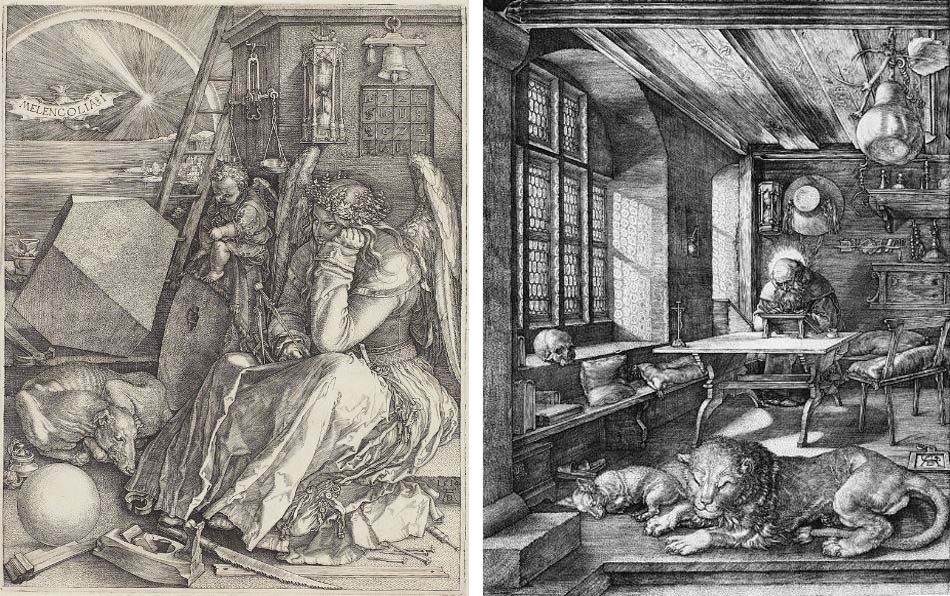
2| Albrecht Dürer, Melencolia I, copper engraving, 1514.
3| Albrecht Dürer, St Jerome in his Study, copper engraving, 1514.
It is interesting that Dame Yates thinks of Dürer’s engraving St Jerome in his Study as Melencolia III, as “the holy man […] seated at his desk profoundly absorbed in his inspired writing” has come to a stage where he can see into the divine truth (Yates 1979, 57-58); even more interesting is her speculation about a possible Melencolia II, now lost except for the copy of it in a different medium than engraving and by a different artist than Dürer. Engravings could travel more easily than paintings; a poet in Elizabethan England would have been unlikely to have seen the German painting his verses sounded like the poetic counterpart to, and likely to have seen the engraving the painting was a copy of – especially for his verses bearing a strong resemblance to the imagery conveyed in another engraving as well.
In The Shadow of Night, a 1594 poem in two parts – Hymnus in Noctem and Hymnus in Cynthiam – by Elizabethan poet George Chapman, a “humour of the night” is described that is clearly a melancholic humour, though the word ‘melancholy’ is nowhere used: a dark, a sad, a weeping humour devoted to profound contemplations and studies that the Night and the Night only is the suitable time for, the Day being meant for men to busy themselves with empty, vulgar and foolish occupations. The Hymnus in Noctem ends with the Moon rising, which Chapman associates with Elizabeth I by stating that, as the celestial body ascends the nocturnal sky, he can feel “the dreadful presence of our Empress” (Chapman, Hymnus in Noctem, 401); in the Hymnus in Cynthiam, the Moon has fully risen and Chapman assimilates its purity – the Virgin Queen’s chastity – to the Saturn-related theme of castration. I find it puzzingly fascinating how, though Chapman is clearly referring to Saturn castrating Uranus (“And as heauens Geniall parts were cut away / by Saturnes hands, with a adamantine Harpey”: Chapman, Hymnus in Cynthiam, 21-22), Dame Yates lapses into stating that he is referring to Saturn being castrated by Jupiter (“the castration of Saturn”, Yates 1979, 141): either way, the god stands for the renunciation of flesh and desire and is therefore associated with the Moon/Elizabeth and the inspired poet’s refusal to indulge in “fleshy sports” (Chapman, Hymnus in Cynthiam, 28). The Shadow of Night is preceded by a letter where Chapman prides himself on being among those noblemen who are bent on pursuing knowledge and cutting off the head of ignorance with “Saturn’s adamantine sword”; he expresses his dislike of the “passion-driven men” who only read “to curtail a tedious hour”; he is, indeed, priding himself on being a Melancholic – on being, precisely, at the second stage of the inspired melancholy, the philosopher’s stage. Chapman’s characterisation of the Night as a black-faced woman, alongside the theme of the dogs as a metaphor for the senses, has Dame Yates guessing that he is familiar with Dürer’s Melencolia I (Yates 1979, 138).
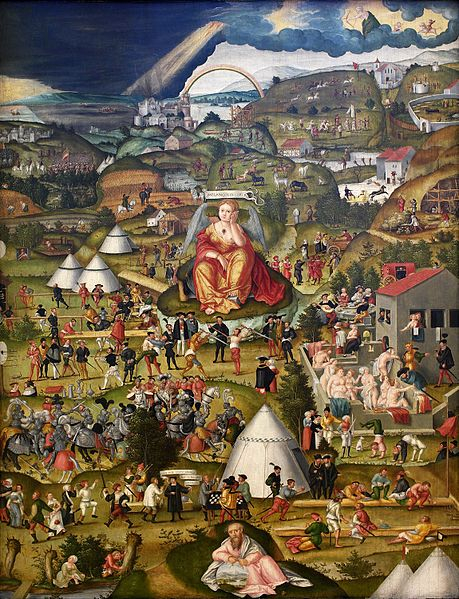
4| Matthias Gerung, Melencolia, mixed media on basswood, 1558, Staatliche Kunsthalle, Karlsruhe.
The verses from the Hymnus in Noctem where Chapman describes the idle occupations of the Day and urges Hercules to shoot an arrow at the Sun in order to stop them and hasten the coming of the Night sound like they are translating one 1558 German painting into words: Melencolia by Matthias Gerung. Gerung’s composition is filled with men and women engaged in any sort of activities; up in the sky, a not clearly identified mythological figure is shooting an arrow at the Sun. In the centre of the scene, a winged woman is sitting, her head resting on her hand, another similarity to Dürer’s Melencolia I being the rainbow that shines in the background; near the lower edge of the painting and in line with the winged woman is a philosopher-like figure absorbed in measuring the globe of the world. In Dame Yates’s guess, Gerung’s painting is the copy of a lost Dürer engraving of Melencolia II that Chapman saw (Yates 1979, 140).
Speculation has been made about William Shakespeare possibly satirising Chapman’s group of learned, ‘Saturnine’ friends in his Love’s Labour’s Lost (written in 1594-1595), where a group of men swear to renounce love and devote themselves to studying. It is actually not so much a satire as a fond and learned homage: one of the men falls for a black-faced woman, gets fervently inspired, and explains the difference to his friends between vulgar lust and the love that elevates the soul. According to Dame Yates, Shakespeare may have known the Christian Cabala; far from being an “appeal to the antisemitic mob” (Yates 1979, 133) like Christopher Marlowe’s The Jew of Malta, his Merchant of Venice is an attempt at Christian-Jewish reconciliation. A study by Daniel Banes, with which Dame Yates agrees only partially, goes so far as to say that Portia acts as the Sephira Tiphereth (Mercy), mediating between Shylock’s Gevurad (Severity) and Antonio’s Hesed (Kindness) (ivi, 129). More easily agreeable upon is Shakespeare’s familiarity with the theme of the inspired melancholy; for example, he is aware of the melancholic temperaments’ alleged proneness to fall under the attack of evil spirits – he has his most famous melancholic character, Hamlet, facing the dilemma whether to trust the Ghost or not: “The spirit that I have seen / May be a devil, and the devil hath power / T’assume a pleasing shape, yea, and perhaps / Out of my weakness and my melancholy, / As he is very potent with such spirits, / Abuses me to damn me” (Shakespeare, Hamlet II.2, 596-601). In Chapman’s The Shadow of Night, Hercules is urged to “cleanse this beastly stable of the world” (Chapman, Hymnus in Noctem 256); Jaques, one of Shakespeare’s melancholics, wants to “cleanse the foul body of the infected world” (Shakespeare, As You Like It II.7, 60): fitting words for the mouth of some angry young rock musician.
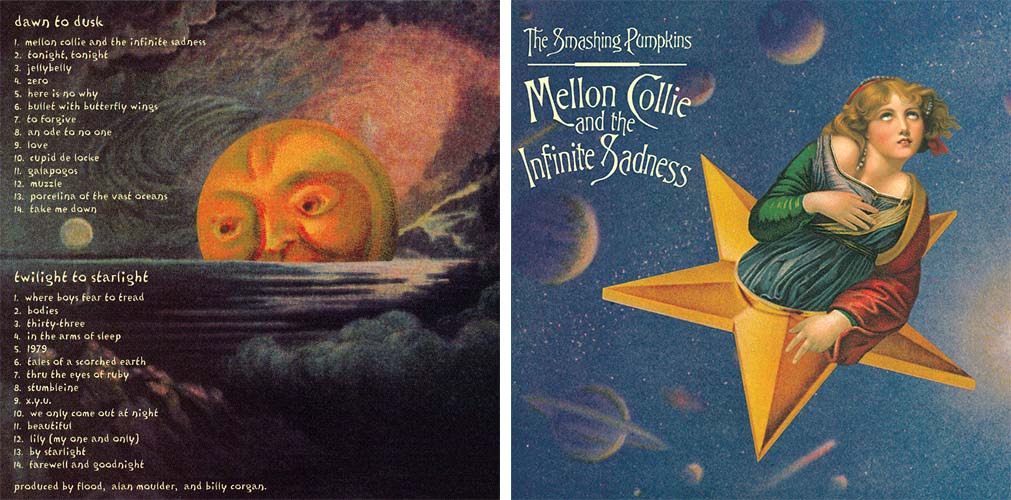
5| The back and front cover of 1995 album Mellon Collie and the Infinite Sadness by the Smashing Pumpkins – digital collage by John Craig.
Despite the term not finding favour with the band’s frontman Billy Corgan, Mellon Collie and the Infinite Sadness by the Smashing Pumpkins can be described as a ‘concept album’. Released in 1995, when the nihilist rage of the Generation X-related countercultures was at its peak, it revolves around an alienated character whose point of view the lyrics are written from and whom Corgan meant to voice the feelings of the youth, and it is interestingly divided in two halves – Dawn to Dusk and Twilight to Starlight – representing Day and Night. The first half, the ‘Day half’, which includes the previously quoted from Bullet with Butterfly Wings and Muzzle, opens with an instrumental the very first song after which is titled Tonight, Tonight, whose lyrics make it clear how eagerly the melancholic narrator looks forward to the night: “We’re not the same, we’re different tonight [...] / We’ll crucify the insincere tonight / We’ll make things right, we’ll feel it all tonight [...] / The impossible is possible tonight”. The day is just something to soldier on through: “the useless drag of another day” (Here Is No Why). The discomfort is blatantly expressed (“Living makes me sick / So sick I wish I’d die” – Jellybelly), and wallowed-in (“Intoxicated with madness / I’m in love with my sadness” – Zero); extremely fascinating is the narrator’s self-depiction as a ‘fool’, just like Shakespearean “Melancholy Jaques”, the ‘non-official Fool’ in As You Like It’s: “Holding back the fool again / Holding back the fool pretends” (To Forgive); “This message is for anyone who dares to hear a fool” (Fuck You [An Ode to No One]). In the second half of the album, a bit of flamboyant theatricality appears (“King of the horseflies, dark prince of death / His tragic forces are heaven sent” – Where Boys Fear to Tread) and a proud statement of belonging to the night is made (“We only come out at night / The days are much too bright” – We Only Come Out at Night). There is still room for bitter disenchantment and sense of isolation (“The empty bodies stand at rest / Casualties of their own flesh [...] / But no bodies ever knew / No bodies / No bodies felt like you / No bodies / Love is suicide” – Bodies), but the narrator’s fear of being doomed to loneliness (“I need someone to ease my mind / But sometimes a someone is so hard to find” – In the Arms of Sleep) dissolves into the bliss of being with their soulmate: (“By starlight I’ll kiss you [...] / By starlight I know you” – By Starlight; “Wonderful, it’s wonderful, to know that you’re just like I” – Beautiful). The beloved one is remarkably called “beautiful as the sun” (Beautiful): the narrator acknowledges the beauty of the hated star. This is the time to feel at peace. “Forever frozen, forever beautiful [...] / The night has come to hold us young” (Thru the Eyes of Ruby).
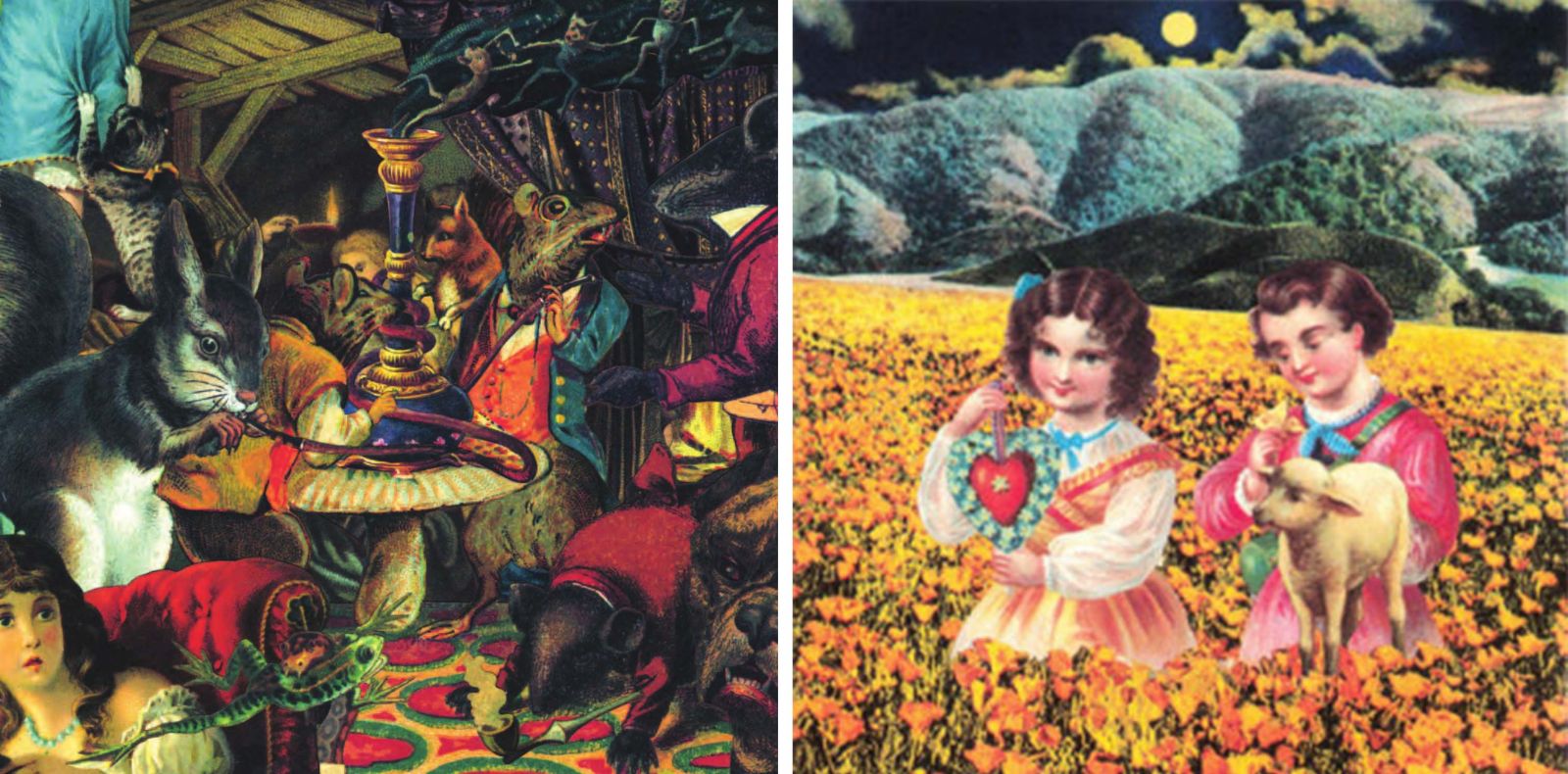
6| Two pages from the Mellon Collie and Infinite Sadness booklet – digital collage by John Craig.
Corgan was resolute about wanting the artwork of the album to be in a Victorian/Edwardian style (the Steampunk, Georges Méliès’s A Trip to the Moon-inspired video for Tonight, Tonight reinforcing that mood). Entrusted with the job was illustrator John Craig, a digital collage artist who assembled his creations by scraps of paper ephemera, following in the footsteps of “the Dadaists and Surrealists, who used collage quite a bit. They actually picked it up from a commercial source, mostly postcards from the turn of the century, which I use a lot myself” (Tyler-Ameen 2012). Fascinated with how pieces in collages “start to become something new just by their association”, Craig succeeded at lending the album the “really dark and dusty” look the demanding musician – whom even an artist who did actual Victorian-style painting had not managed to satisfy – was looking for. Amidst the turn-of-the-century-esque children and humanised animals, the most powerful image in the booklet – the one on the front cover – was born of two pieces that were not from that era at all.
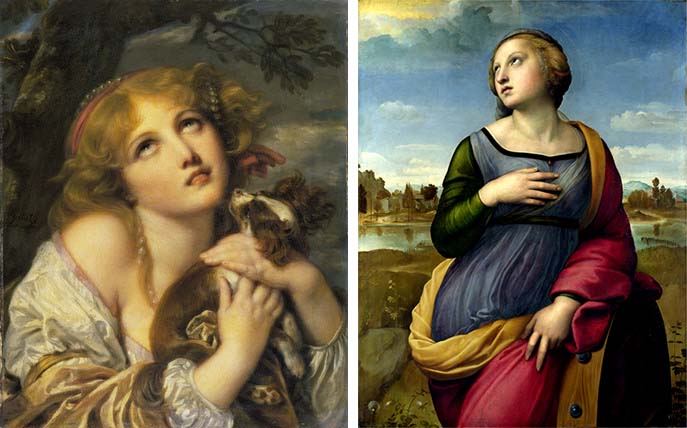
7| Jean-Baptiste Greuze, The Souvenir (Fidelity), oil on canvas, c. 1787-1789, The Wallace Collection, London.
8| Raphael, Saint Catherine of Alexandria, oil on wood, c. 1507, National Gallery, London.
"A melancholic beauty […] hurtling through the empty infinity of space” who captures “the essence of an aimless and alienated youth” (Kennedy 2016 [emphasis mine]), “a daydreaming star nymph with a split personality” (Tyler-Ameen 2012 [emphasis mine]), the breathtaking figure has the face of the woman in Jean-Baptiste Greuze’s 18th-century painting The Souvenir and the body of Raphael’s Saint Catherine of Alexandria; as for the star her body is inserted into, it is from a whiskey advertisement that showed the drinks floating on stars. (Corgan wanted a celestial imagery for the cover – the background is from an old children’s encyclopedia). “It was done with a color copier, so I had some flexibility in tweaking the color and adjusting the size […]. You put the body on the star and the head on the body and you just know it’s right somehow”, Craig has recalled, explaining how the flowing dress of Saint Catherine, “the way it is rippling and almost traveling” – also by virtue of the energy of its primary colours – was apt to convey the idea Corgan had in mind: “a ship’s maiden – you know, the ones carved into the front of old ships” (ivi). The dreamy, ecstatic expression of the Greuze woman (who indeed sports silent screen diva eyes, things coming full circle with the Méliès-inspired Tonight, Tonight video) is a perfect match for that; the fusion is seamless.
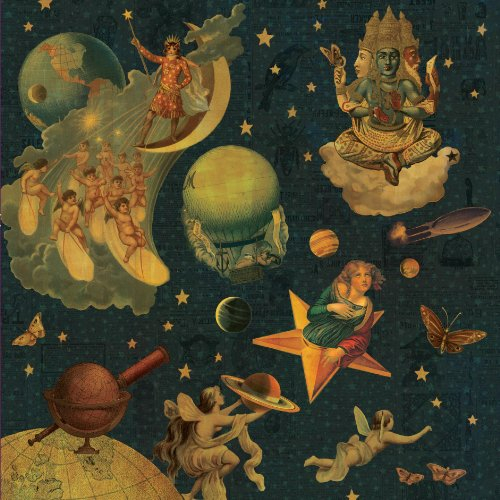
9| The front cover for the 2012 deluxe edition of Mellon Collie and the Infinite Sadness – digital collage by John Craig.
Upon being asked whether he thinks Saint Catherine’s pose – her left hand draped below her waist – implies autoeroticism, Craig said: “I see that in a lot of paintings of women from those periods […]. She may be [masturbating], and maybe only Raphael knows […]. That’s all they [the Renaissance artists] could get away with” (Tyler-Ameen 2012). That is surely a pertinent remark: women’s hands in Renaissance paintings have told revolutionary tales. I have spoken on this subject over the course of a talk I have delivered at the History of Art Department of Sapienza University of Rome. But of Craig’s fusion of Raphael and Greuze a woman is born for the cover of the Victorian-flavoured booklet of an album revolving around the theme of melancholy: my interpretation of her – to which the cover Craig provided for the 2012 deluxe edition of the album, where she is no longer alone, but surrounded by Victorian-esque figures, led me all the more – is the Victorian female melancholic, a hysteric in the pre-Freudian sense, a victim of the period-typical sexual repression caressing herself into relief. Craig, whom I reached via his website’s contact form in order to enquire about his thoughts on my guess, was so kind as to get back to me. He told me that he and Corgan were simply looking for something iconic, something striking and imposing – a ship’s maiden-like figure; nevertheless, he acknowledges the sense of mystery that permeates actual Victorian art and is therefore not dismissive of an interpretation based upon an insight into that era. Craig’s own illustrations are mysterious: “they hint at stories and narratives and invite you to find your own interpretations” (Kennedy 2016). To Philip Kennedy, “the Pre-Raphaelite imagery provided a grandeur that fitted the ambition of the album” (ivi). It did more than that: it had the mysterious quality of Victorian art and Craig’s art colliding harmoniously.

10| Claude Du Bosc after illustration by Louis Du Guernier, Frontispiece for The Rape of the Lock, steel engraving, 1714.
11| Claude Du Bosc after illustration by Louis Du Guernier, Morning Dream (Canto I) for The Rape of the Lock, steel engraving, 1714.
12| Henry Fuseli [Heinrich Füssli], Dream of Belinda, oil on canvas, 1789-1790, Vancouver Art Gallery.
13| Aubrey Beardsley, The Cave of Spleen (Canto IV) for The Rape of the Lock, pen and ink drawing, 1896.
A case of equation of melancholy and the female sex (more precisely, of melancholy and menstruation, as can be deduced from the reference to age “fifty from fifteen”) is Canto IV in Alexander Pope’s poem The Rape of the Lock (1712), where the main character Belinda has a lock of her hair cut unexpectedly by a nobleman (“the Baron”) and the gnome Umbriel flies down to the “Cave of Spleen” to fetch the rage and tears she needs in order to claim it back. The gloomy place is stereotypically female-connoted: a constantly migrainestruck Queen presides over it, her ladies-in-waiting an “ancient Maid” and a simpering “Fair-one”. After being paid honour to by Umbriel (“Hail wayward Queen! / Who rule the Sex to Fifty from Fifteen, / Parent of Vapors and of Female Wit, / Who give th’Hysteric or Poetic Fit, / On various Tempers act by various ways, / Make some take Physick, other scribble Plays” – Pope, The Rape of the Lock, IV, vv. 57-62 [emphasis in original]), the Queen gives him a bag: “There she collects the Force of Female Lungs, / Sighs, Sobs, and Passions, and the War of Tongues. / A Vial next she fills with fainting Fears, / Soft Sorrows, melting Griefs, and flowing Tears” (vv. 83-86). Once Umbriel is back by Belinda’s side, “Full o’er their Heads the swelling Bag he rent, / And all the Furies issued at the Vent” (vv. 91-92). In the light of what has been previously discussed in this paper, Pope’s mention of a “Poetic Fit” for the melancholic woman that has her “scribbling plays” is strikingly remarkable – though the poet is more than probably intending mockery.
The title of the poem figures the cutting of the lock as an actual sexual assault (and rightfully so). Belinda is sunk helplessly in a girlfriend’s arms when Umbriel comes back to her from the Cave; according to Viola Papetti, a parallel can be drawn with John Milton’s 1634 masque Comus, where the main female character (“the Lady”) finds herself immobilised by the magic of the debauched god Comus, who unsuccessfully tries to talk her into surrendering her virtue (Papetti [1984] 2007, 22). An angelic figure, the Attendant Spirit, helps the Lady’s brothers chase off Comus, then conjures the nymph Sabrina who frees her from the immobility spell. In his short poem Il Penseroso (1631), Milton proves himself acquainted with the theme of the inspired melancholy, which he had probably come to know through Chapman: he describes the dark face of Melancholy, whom he claims to be the daughter of Saturn; Comus, with its chastity theme, is an Elizabethan-esque work as well. Milton “was the inheritor of the thought of a special messianic role for England; he inherited it from Spenser and the Elizabethan poets, particularly perhaps from Raleigh” (Yates 1979, 179-180); his vision for England “was that of a nation of chosen people, chosen in the Hebraic sense, chosen to lead Protestant Europe against the power of Papal Antichrist. Spenser had envisaged Elizabethan England and its queen as chosen for just such a religious role”, the only difference being “that Milton was not a monarchist, like Spenser, but a republican” (ivi, 177). The Lady in Comus is a pure, chaste heroine like the Virgin Queen around whom Spenser and Raleigh had built their cult. Spenser’s poem The Faerie Queene (1590) exalts chastity and is infused with Christian Cabala and Christianised white magic – like the Attendant Spirit’s. Fairies as firm enemies of lust is a recurring theme in British literature; in Shakespeare’s The Merry Wives of Windsor, the villagers disguise themselves as fairy folk before they punish Falstaff. In The Rape of the Lock, though, the gnome Umbriel performs a different magic than the Attendant Spirit does in Comus: he pulls Belinda out of her frozen state by just fetching her own spleen.
Artists, as Papetti points out, have drawn on the poem’s debt to Comus: Du Guernier inserted a faun – a Comus’s follower – in his illustration for the frontispiece, and hid a faun’s paw under Belinda’s dressing table in the one for Canto I; Fuseli turned to Shakespeare’s fairy imagery for inspiration, inserting Robin Goodfellow and Queen Mab in his Dream of Belinda and thus acknowledging Milton’s own debt to the Bard; in Beardsley’s depiction of the Cave of Spleen, Umbriel is in human attire, like the Attendant Spirit in his shepherd’s disguise, and there is a female figure in the lower right corner that Papetti considers to be a water nymph like Sabrina (Papetti [1984] 2007, 22-23). The Fuseli painting, “an unrecorded canvas which has lain in obscurity in the Vancouver Art Gallery for more than thirty five years”, has long been referred to as Queen Mab (Kalman 1971, 226). Now that its subject has been correctly identified, the moon on the fairy queen’s head takes on a special meaning: the moon cycle is the alleged source of Belinda’s spleen. To paraphrase the melancholic prince of Denmark, more mysteries were believed to be in a woman’s womb in those pre-psychoanalytic days than philosophy could dream of.
By taking both high and popular culture into consideration, this paper was aimed to show how ‘energies’ from the past can be reused. To this end, drawing on a lesser known academic source has proved invaluable: Dame Frances Yates’s amending of the flaw in the more well-known work by Panofsky and exhaustive elucidation of the inspired melancholy as opposed to the frustrated one make clear the difference between Chapman’s poem and Corgan’s lyrics that would otherwise be at risk of slipping by unnoticed. Due to the central role that the Elizabethan age has in the paper, the themes of melancholy and sex are strongly intertwined, highlighting the shift from the Elizabethan exaltation of the inspired chastity into the Victorian repression. Seeing as it was music journalist Daoud Tyler-Ameen’s interview with John Craig that led me to develop my own interpretation of the woman on the cover of Mellon Collie and the Infinite Sadness, the inclusion of non-academic sources has indeed been the key to writing this paper.
Bibliography and webgraphy
- Kalman 1971
H. Kalman, Füssli, Pope and the Nightmare, “Pantheon” 29:3 (May/June 1971), 226-236. - Kennedy 2016
P. Kennedy, Smashing Pumpkins and the Infinite Talents of John Craig,
http://illustrationchronicles.com/Smashing-Pumpkins-and-the-Infinite-Talents-of-John-Craig, October 23, 2016. - Papetti [1984] 2007
V. Papetti, Foreword to Alexander Pope, Il riccio rapito [The Rape of the Lock], Italian translation by Viola Papetti, Milan [1984] 2007, 7-26. - Tyler-Ameen 2012
D. Tyler-Ameen, ‘Mellon Collie’ Mystery Girl: The Story Behind an Iconic Album Cover,
http://www.npr.org/sections/therecord/2012/12/07/166414108/mellon-collie-mystery-girl-the-story-behind-an-iconic-album-cover, December 7, 2012. - Yates 1979
F. A. Yates, The Occult Philosophy in the Elizabethan Age, London 1979. - Additional sources
The author would like to thank Mr. John Craig for discussing his artwork for Mellon Collie and the Infinite Sadness with her over email
Abstract
Drawing extensively on Dame Frances Yates’s essay The Occult Philosophy in the Elizabethan Age – which has the merit of pointing out a minor flaw in Klibansky, Panofsky and Saxl’s seminal work Saturn and Melancholy – and with an email exchange between the author and artist John Craig providing a precious help, the paper covers a 16th to 20th century time span, conjuring up a carousel of virgin queens, hysterical women, inspired poets and nihilism-consumed young rockers; it draws a comparison between the treatment of the theme of Day and Night in Saturnine poet George Chapman’s The Shadow of Night and the Smashing Pumpkins’ grunge counterculture milestone concept album Mellon Collie and the Infinite Sadness, the Victorian-flavoured artwork of the latter leading to an excursus into Victorian melancholy and the pre-Freudian understanding of hysteria that in turn calls for a step back into the 18th century and Alexander Pope’s female-connoted “Cave of Spleen”.
keywords | Melancholy; Chapman; Smashing Pumpkins; Hysteria; Pope.
Per citare questo articolo/ To cite this article: British Poets and American Rockstars. A Journey through the Cave of Spleen, a cura di M. Paolucci, “La Rivista di Engramma” n. 149, settembre 2017, 47-59 | PDF dell’articolo
